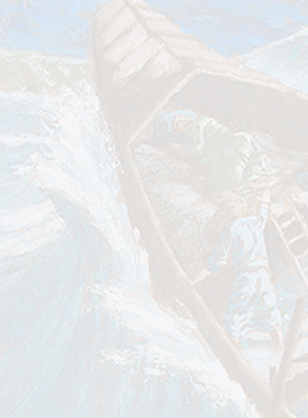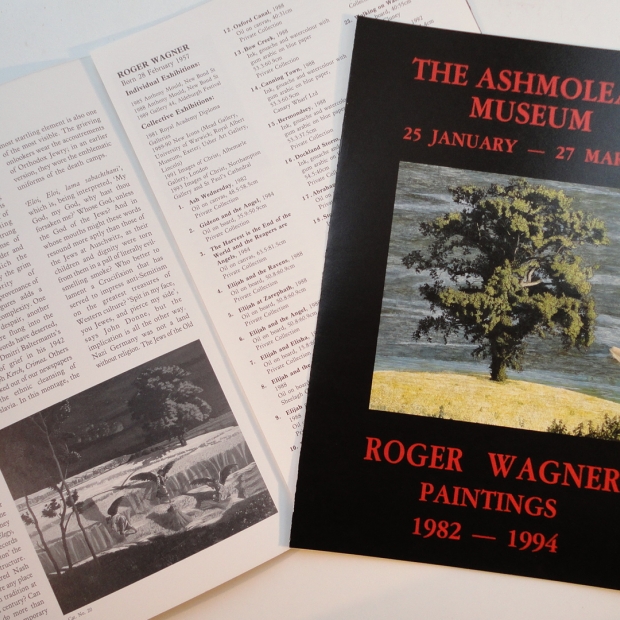Work > Articles
The Orient Corn Chris Miller 1994
The Orient Corn
There is a 'technical' progress in 20th century art. The Fauve defies conventions of colour, the Cubist those of static perspective; abstract expressionists dramatise processes of creation, conceptualists those of reception. This succession cannot simply be ignored. The decision to paint in a style more akin to Poussin than to Munch, Grosz, Picasso or Scully is therefore significant. It is not one which Roger Wagner took in that form;
he liked Giorgione more than Picasso and wanted to paint like him. When people said he shouldn't, he ignored them. The importance of Christian iconography in painting suggests an analogy between the collapse in the social authority of Christianity and the collapsing conventions of representation. Wagner's own beliefs are, in this perspective, old fashioned; they include the agency of God in this world. Expressed in paintings which bring angels to the cornfields of Suffolk, scything and sheaving in the costume of 18th century peasants, they might seem like nostalgia if hot simply reaction. This is the century of the Holocaust. Palmer's tumescent crops were Virgilian at a time when the tide had long turned away from Augustanism; their pastoral came thirty years after the French revolution. Now they seem ahistorical. But Gray's Elegy, set so close to Shoreham, records in its 'mute inglorious Milton' th absence of a career structure. Though Palmer inspired Nash and Sutherland, is there any place for this very English tradition at the end of the 20th century? Can a visionary style do more than wince away from contemporary reality?
The painting called Menorah is one answer to this question. Wagner is not the first artist to transpose the Crucifixion to another place and time, but the juxtaposition of Christ and cooling towers is a startling one. This is not the intensely focused grief of Rosso's equally startling Deposition. The figures strung across this flooded expanse of loam seem intent on wider and other griefs, to which the crucifixions bring only the grim rhythmic authority of transcendence. The provenance of certain of the figures adds a further strand of complexity. One who stoops in despair, another whose arms are flung into the space which words have deserted, derive from Dmitri Baltermants's portrayal of grief in his 1942 photograph Kerch, Crimea. Others have looked out of our newspapers from the ethnic cleansing of Yugoslavia. In this montage, the most startling element is also one of the most visible. The grieving onlookers wear the accoutrements of Orthodox Jewry; in an earlier version, they wore the emblematic uniforms of the death camps.
'Eloi, Eloi, lama sabachthani', which is, being interpreted, 'My God, my God, why hast thou forsaken me?' Whose God, unless the God of the Jews? And in whose mouths might these words resound more aptly than those of the Jews at Auschwitz, as their children and dignity were torn from them in a pall of literally evil- smelling smoke? Who better to lament a Crucifixion that has served to impress anti-Semitism on the greatest treasures of Western culture? 'Spit in my face, you Jewes, and pierce my side', says John Donne, but the implication is all the other way. Nazi Germany was not a land without religion. The Jews of the Old Testament, the heroes ofRacinian tragedy, appear in Western literature as the righteous forbears of the Christians who conducted the pogroms. The Jewish Christians at the foot of the cross lament the loss of all their hope;
the intervention of God in their lives is apparently annihilated in Christ's death. The smoke that the Jews watch sweeping up into the clouds evokes the ashes carried by the wind over the bleak Polish plains. And a parallel is established. We are in the presence of the cross, but the six cooling towers and the central chimney make up the seven branches of the Menorah, the ritual candlestick which defines the holiness of the Jewish holy place and thus marks the presence of God. For Jews and Christians alike, the face of desolation wears (inevitably, as the agnostic observes) another aspect, that of the presence and providence of God.
In the gloomy forms that preside in the painting's background, the colossal mechanisms of the state themselves achieve a status like that of destiny. Christ was crucified, if not at the state's behest, by the state. We depute to the state titanic powers that we do not control and cannot always trust; our own obscure apprehensions accompany our knowledge of its exercise. Our own century has seen such apprehensions more than fulfilled;
our wildest dreams of horror have been eclipsed by the functioning of an industrial society which used its technology and organisation to administer a systematic death. Capitalist considerations played their part in the functioning of Nazi and Stalinist death camps. The considerations which should determine conduct towards other humans were overlooked. These are not simple implications, but they suggest how Wagner is able to bring to bear upon lives lived under the light of the electric filament a politics of transcendence.
They also serve to suggest why a figurative technique is necessary. Wagner is a gifted lay preacher, and sufficiently devoted to his God to have considered and rejected the possibility of giving up painting for ordination. His concern with the representation of his faith crystallizes in moments of the Biblical narrative which stand rather outside the scope of abstract painting, in which Biblical reference could only be an accretion of non-visual significance. Comparison of recent winners of the Turner Prize with the Christian iconographical tradition is not necessarily in their favour. At issue here is our capacity to narrate and refer in an art-form still reckoned central to our culture. Wagner's rejection of current trends, of the claim that the century itself commands a style determined by the evolution of critical and artistic expectations, is not made in ignorance.
Even so, how are we to interpret these peasant-angels calmly scything the Suffolk fields? The fulminations of a Last Judgement are missing. It is customary to represent the end of the world with Michelangelesque terrors; the instruments of torture designed for the correction of criminal and heretic in the real world can be seen at work in depictions of the Last Judgement. Memling's Last Judgement at Gdansk might serve as a metaphor for the Holocaust. In the perspective of Christianity, the element of fear is not inappropriate; there is nothing worse than exclusion from the love of the living God. Christ died to lift that excluding burden of sin. But the words we hear are Christ's: 'the harvest is the end of the world; and the reapers are the angels. As therefore the tares are gathered and burned in the fire; so shall it be in the end of this world'. 'Wailing and gnashing of teeth' are mentioned. This therefore is truly a painting of faith, for what we see is our harvesting. The world that follows, in which 'the righteous shall shine forth as the sun in the kingdom of the father' is one at whose methods and goals faith can hardly baulk. For others, this blithe confidence will evoke other analogies. For Wagner, the prospect of benefit is literally infinite, and the metaphor of harvest appropriate. There is a terribilitas to this pastoral.
In one respect - identification of vision and landscape - the analogy with Palmer is clear. Wagner's association with the landscape of Suffolk dates from childhood. It is the locus of his faith, the emblematic pastoral innocence:
'The Green Trees... Transported and Ravished me, their Sweetnes and unusual Beauty made my heart to leap,. . . they were such strange and Wonderfull things'. It is also the symbolic landscape of The Harvest: 'The Corn was Orient and Immortal Wheat, which never should be reaped, nor was ever sown. I thought it had stood from Everlasting to Everlasting'. Of the integrity of this identification, the clearest witnesses here are the studies of the Four Seasons, which represent episodes in the life of Elijah. Something of the Suffolk landscape, its low horizons and flat expanses of contrasting colours, the stillness of its estuaries, has entered Wagner's style. In this exhibition, two paintings, See What Desolations and Storm with Willowherb, derive from the impact on the Aldeburgh landscape of the 'tornado' of Spring 1989, while in Abraham and the Angels, the Old Testament scene is played out in the Suffolk landscape beside the nuclear reactor of Sizewell 'A', in a serene confrontation of natural, unnatural and supernatural.
To represent Wagner as a pastoral painter is nevertheless misleading. Among the most striking images are those of the London Docklands. They powerfully illustrate Wagner's capacity to introduce into his representation what I have called 'the politics of transcendence'. The Docklands are themselves already a locus of myth. Bankrupt development and policy on a background of post- imperial decadence, or a startling, abrupt regeneration thrust from the stinking Thames mud, to describe them is to adopt political terminology. The wharves and warehouses have outlived functions that prescribed their forms, and their forms have come to signify their abandonment. This is the metaphor they are made to serve: 'How shall we sing the Lord's song in a strange land?' What is the Lord's song in this context? The past that made these docks is not desirable in itself, nor perhaps the culture which is transforming them, yet something in the order they inscribe upon the river landscape, something about purpose; energy, and activity speaks of ideals which their abandonment falls short of. In these paintings Wagner's strategy is neither to state an ideal nor to allow overt political comment to colour his representations. These are very still paintings their blue, grey and brown tonalities and successive layers of glaze fix a remoteness easily related to Psalm 137's lament: 'By the waters of Babylon, there we sat down, yea, we wept, when we remembered Zion'.
Wagner's progress as a visionary artist is, in short, that of a cunning innocent. There is no blindness in this innocence. Traherne speaks of his childhood Wonder: 'Harsh ragged objects were conceai'd, Oppressions Tears and Cries, . . .were hid'. Wagner, in contrast, writes: 'The mirrors of Almighty God/ Have Oxford Street as their love bower/ They leave their names in public phones/ And sell themselves for half an hour'. His faith perceives without embracing the meretricious and the atrocious, Menorah is both unforgettable witness and a breath of formal and doctrinal redemption. His cunning as a maker of images is as radical as his innocence. The Burning Fiery Furnace is set in Oxford, in Lucy's Ironworks in Walton Street, accommodates that time-capsule's collocation of Victorian structures and fiery modern technology. Within the furnace, the three companions are engulfed in the astonishment of faith. The angel to whom they turn has a hieratic splendour that makes burning love a metaphor in the real world, their astonishment, and the multifarious implications of this setting, offer the spectator a way into that love. In the sonnet quoted above, Donne speaks of his own sin crucifying Christ daily, 'Oh let mee then, his strange love still admire' is his conclusion. Wagner's admiration of that 'strange love' is the source of these images. He celebrates the Affirmative Way in making of every tree a susurration of angels;
in seeing inhumanity for what it is, his work celebrates the necessary, if distant, prospect of redemption. The radical courage of his enterprise is an invitation to courage in our own.
Christopher Miller
© 1994

